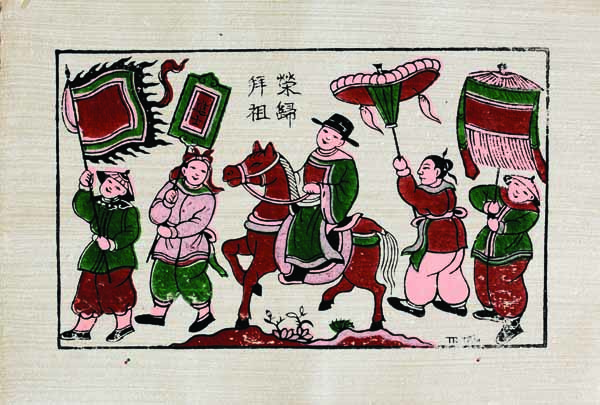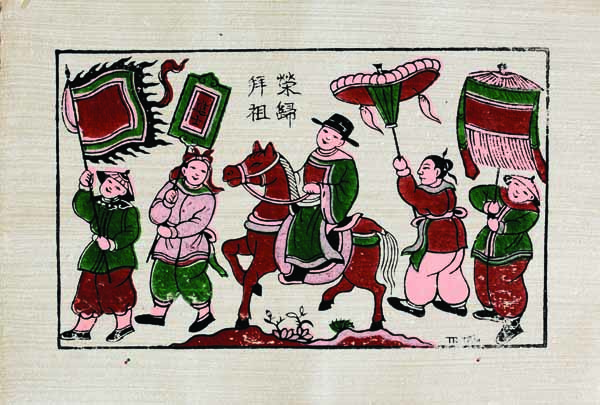(No.1, Vol.8,Feb -March Vietnam Heritage Magazine)

Dong Ho painting *

Dong Ho painting *
Historically, Viet people considered that schooling was the only way to advance in life. Scholars were the most respected class in the society, above farmers, who were second. And the only way to become a scholar was to go to school. Only when life becomes uncertain due to natural diasters or social upheavals, or when finding the next meal is the constant worry, the farming profession becomes preferable.
The drive for learning was expressed not only in folklore literature and proverbs, but also in folk art.
Take a look, for example, at the Dong Ho painting ‘Toad Scholar’. Toad, a familiar and usually ignored animal in a farmers’ mundane life was personified as a guru solemnly sitting at a table and teaching kids. It’s a familiar scene in the old times in Vietamese villages. Confucianist scholars, usually those who hadn’t yet succeeded in official selection exams, often opened a school to educate village youth. There were also successful ones who renounced their high career to go home and spread wisdom, such as the celebrated scholar Chu Van An. The class shown in the painting is simple and rigid. One pupil is spanking another with a whip, obviously for being unattentive or mischievous. Another pupil is respectfully pouring tea for the teacher. The rest of them are reading their books.
A few brief brushstrokes in ‘Toad Scholar’ say it all: respect the teacher and study hard, or receive harsh punishment. The picture shows the philosophy of strict education of the past, ‘Whipping is the expression of love.’ The forging of letters and personality is done by the whip. The principle ‘First learn the code, then learn the letter’ has forged a countless number of great scholars who made up the ‘Sap of the Nation’ (words of academician Than Nhu Trung), who made history, and whose names are eternalized on stone stelae at the Temple of Letters, Hanoi.
Living in hardship, farmers of the old times strove to change their lives, hoping their children would succeed through learning. The image of poor buffalo kids devoutly absorbing knowledge is abundantly reflected in folk art, for example, in the image of a boy sitting on a buffalo hungrily devouring a book, or a child with a book in the left hand and the buffalo leash in the right. In the old times, people believed that studying was the only noble line of work; all others were base. Through the image of a handsome little boy in a beautiful outfit, brimming with health and reading a book, our ancestors expressed their dream that their descendants would become learned, successful and happy and continue the family line in glory.
The illustrious story about the friendship of Luu Binh and Duong Le is also retold in folk art. The two friends both attended an official selection exam, but only Duong Le passed and became a mandarin. He started, with the help of his beloved wife lady Chau Long, to secretly, motivate Luu Binh to study hard and succeed like himself. Every Vietnamese knows the story by heart.
Some talented young men, mentioned in historical records as geniuses, achieved success very early in life, becoming great mandarins, or ambassadors to represent our nation at the Chinese imperial court with dignity and therefore command respect. Esteemed by the Royal court and cherished by the people, they were bright examples for the whole society to follow. One successful man meant pride and honor for the whole clan, the whole community. Many paintings depict the scene of a newly-appointed scholar coming home to recieve due respect from the community and to pay homage at the ancestral altar.
This painting is quite good. The newly-appointed mandarin leisurely rides on horseback, with servants carrying flags to clear the road and parasols to keep him in the cool shade. The recognition paid to yesterday’s poor student, who is now triumphant, cliché though it may be, proves the worthiness of the investment and endeavor of the family and the whole clan.
Ancient Vietnamese never suffered lack of lucidity or humor. The glorious scholar with scholarly degree may be depicted as a rat. Sometimes the whole procession is depicted as one of rats behind a rat scholar riding on a horse, looking back at four rats carrying a palaquin with his lady rat inside. The leading rat carries a flag with characters ‘Top scholar’. A rat plays a drum, another blows a fanfare, and yet another one offers a fish to a big cat on the roadside. The ancient artist couldn’t resist inserting an ironic message, which said even high scholars have to obey unwritten rules and bribe the local authorities. The corrupt nature of village officials is manifested even during the happy occasion of recieving a talented and successful son of the community who comes back to pay homage to those who brought him up.
There is another version of this painting which is no less famous but titled ‘Rat Wedding’. The two paintings use the same scenes between rats and cats but with different title and annotation, perhaps because the intended meanings are different. Whatever the case, these are beautiful paintings in which ancient folk artisans used the image of rats to encourage learning.
Another image seen frequently in folk paintings is that of a high-ranking scholar, constantly holding a book in his hand. Perhaps reading is a never-changing feature of the erudite mandarins, and the common people always wish it to also be the image of their descendants.
Sometimes, being illiterate and wishing their descendants to be given a chance to good education, people revered letters and hung letters on the altar at home. They also used to hang character paintings during New Year’s. The whole painting contains only one character: Godsend, Longevity, Happiness or Prosperity. In folk art, these characters also contain graceful and elegant brushstrokes seen in paintings of other kinds.
Folk paintings are an invaluable aesthetical heritage. They perpetuate the aspiration for learning and knowledge of the Viet people.

Dong Ho woodblock prints appeared around 17th century. They are from a school of Vietnamese folk art which originated from Dong Ho Village, Song Ho Commune, Thuan Thanh Dstrict of Bac Ninh Province. Dong Ho prints vividly reflect ancient Vietnamese agricultural society and the personality of Vietnamese farmers through their customs and everyday life activities. To produce a single print, multiple print blocks are made, one for each color. The black print is the most important one. The paper used for printing is the traditional poonah paper coated with a mix of ground seashell and rice flour. The colors are natural extracts. Yellow is taken from Japanese pagoda tree, red from day lily, white from ground seashell, and black from bamboo leaf ash. Dong Ho folk art is a National Intangible Cultural Heritage of Vietnam.
Hang Trong art is another form of folk visual art in Vietnam, beginning mainly in Hang Trong and Hang Non streets of ancient Hanoi about 400 years ago. This school of art is almost extinct today, with some of its best known products still being displayed in museums. Artisan Le Dinh Nghien is the only person left from this art school. Hang Trong pictures were half printed and half painted. The print block only contains black lines. The rest is painted with a broad soft brush, one side of which is dipped in color and the other in water in order to use blurring techniques. From an original carved block, multiple pictures are printed using pure Chinese ink. The painting part is done, of course, manually. The paper then is strengthened by pasting one or more layers of paper on its back side. The number of layers depends on the intended frame and use. As the glue dries, the picture is painted again. One picture may take three to four days to be completed.

